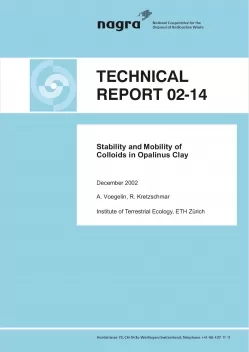
Technical Report NTB 02-14
Stability and Mobility of Colloids in Opalinus Clay
The Opalinus Clay formation in northern Switzerland is currently under evaluation for its suitability as a host rock for a spent fuel, vitrified high-level waste and long-lived intermediate level waste repository. The Swiss concept of geological disposal of radioactive waste is based on a multi-barrier system. In the near field, spent fuel and vitrified high-level radioactive waste are contained in massive steel canisters surrounded by a dense bentonite clay barrier. The long-lived intermediate-level waste, on the other hand, is surrounded by cementitious materials in separate emplacement tunnels. In the far field, the host rock formation is expected to act as an effective barrier for radionuclide migration. In this report, we discuss the potential role of mobile colloidal particles in facilitating radionuclide transport through the Opalinus Clay formation (far field). Since rock fractures resulting in preferential flow paths are not expected in Opalinus Clay, we limit the discussion to convective-diffusive transport through the rock matrix.
Numerous reports in the literature have suggested that mobile colloidal particles in subsurface porous media may serve as carriers for strongly sorbing contaminants, such as many radionuclides, and thereby facilitate contaminant migration. The objective of this report is to (i) discuss the potential composition of colloidal particles in Opalinus Clay, (ii) evaluate the colloidal stability of colloids in Opalinus Clay under consideration of the pore water chemistry, (iii) discuss the potential mobility of colloidal particles in Opalinus Clay under various assumptions concerning flow conditions and colloid-matrix interactions.
The most relevant types of colloids in Opalinus Clay were inferred from the rock composition and from reference pore water chemistry. These include clay minerals, quartz, calcite, iron oxides, and organic matter. An evaluation of published data on surface charge and colloidal stability of these types of colloidal particles suggests that they would readily aggregate in Opalinus Clay pore water, which has a high ionic strength (~0.1-0.3 M) and neutral to slightly alkaline pH (~6.8-8.2).
Based on the texture of Opalinus Clay and hydrologic parameters, simple diffusion, advection, and colloid filtration calculations were conducted. Colloidal mineral particles larger than ∼ 60 nm are expected to be rather immobile, since they settle by gravitational forces. Also, the mesoporous structure of Opalinus Clay is likely to limit their mobility by physical straining. Colloidal particles smaller than ∼ 60 nm are expected to be removed very effectively from the pore water by diffusion and deposition to immobile matrix surfaces. Maximum travel distances (99.99 % removal) of colloidal particles, as calculated by filtration theory, are therefore below 1 m even under worst-case assumptions. In summary, the mobility of colloids in Opalinus Clay is expected to be extremely low due to the following factors: (i) high ionic strength of pore water and resulting low colloidal stability, (ii) mesoporous structure of Opalinus Clay and resulting filtration by physical straining, (iii) extremely low hydraulic conductivity and advective pore water velocity in Opalinus Clay, (iv) much slower diffusion of colloidal particles compared with dissolved radionuclide species.
In conclusion, Opalinus Clay contains various types of colloidal size particles, but their colloidal stability and mobility is expected to be extremely low due to both chemical and physical factors. Thus, colloid-facilitated transport of radionuclides in Opalinus Clay is unlikely, as long as fracture flow does not occur. If further hydrogeologic studies reveal the relevance of fracture flow, the role of colloids needs to be re-evaluated in this con text. The composition of Opalinus Clay organic carbon and dissolved organic carbon and its potential role in radionuclide migration through Opalinus Clay requires additional research.
